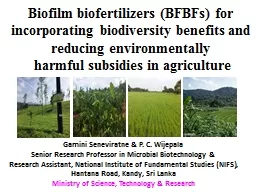

incorporating biodiversity benefits and reducing environmentally harmful subsidies in agriculture Gamini Seneviratne amp P C Wijepala Senior Research Professor in Microbial Biotechnology amp ID: 912612
Download Presentation The PPT/PDF document "Biofilm biofertilizers (BFBFs) for" is the property of its rightful owner. Permission is granted to download and print the materials on this web site for personal, non-commercial use only, and to display it on your personal computer provided you do not modify the materials and that you retain all copyright notices contained in the materials. By downloading content from our website, you accept the terms of this agreement.
Slide1
Biofilm biofertilizers (BFBFs) for incorporating biodiversity benefits and reducing environmentally harmful subsidies in agriculture
Gamini Seneviratne & P. C. WijepalaSenior Research Professor in Microbial Biotechnology & Research Assistant, National Institute of Fundamental Studies (NIFS), Hantana Road, Kandy, Sri LankaMinistry of Science, Technology & Research
Slide2How to create plant diversity in natural forests Thinning of tree seedlings of the same species growing at high densities on the forest floor, via consumption by some microbes and fauna (insects) feeding on plants
Open up gaps on the forest floor for tree seedling of other species too to emerge in the same mannerDiversity & stratifications in the forest ecosystem (Bagchi et al., 2014, Nature 506, 85-88). Those microbes & insects, considered as forest-creating Engineers
Slide3Forest conversion to agricultureReduce biodiversity of functional flora, fauna and microbes Forest clearingTillage Chemical inputs
Because,
t
hey enter into an inactive or dormant phase to bypass the stress factors, by forming ‘seeds’
Then, those remnant forest diversity/stratification creating microbes and insects in the
agroecosystems start feeding on our cropsThen, we call them pathogens and pests attacking our crops
We address above issues by killing pests and pathogens using agrochemicals, and by further increasing chemical fertilizer use with yield decline, which contribute to further depletion of the biodiversity & aggravate the issues.
Thus, we are wrong in the current approach of conventional agriculture
Slide4A transformation is neededRapidly overheating climate, degraded soil, depleted water resources – contribute to further biodiversity loss
Slide5How to reinstate the lost biodiversity (Conventional approach)Mainly to increase microbial diversity & soil fertilityCrop rotation Agroforestry systemsOrganic fertilisers (compost etc.)Application of mono or mixed cultures of microbial biofertilisers, biocontrol agents (e.g. nitrogen fixers, P solubilizers, Bacillus spp., Pseudomonas spp. etc.)
Long term
Slide6New biofilm approachDeveloped microbial biofilms (surface-attached microbial communities) secrete a wider range of environmentally important compounds than mono or mixed cultures of microbes without surface attachment, some of which break dormancy of soil seed banks of flora, fauna & microbes, thus reinstating lost biodiversity (short term)
Slide7In 2003, we introduced the concept of biofilm-based biofertilizers (Seneviratne, 2003, Curr. Sci. 85, 1395-1396), with the name Biofilmed biofertilizers (BFBFs, a patented biotechnology)Fungal-bacterial biofilms (FBBs) used for developing BFBFs
Slide8Locations (25) and crops (12) of field experiments conducted with biofilm biofertlizers (BFBF) in different districts (12) of Sri Lanka
Slide9Table 1. Mean crop yields following application of biofilmed biofertilizer (BFBF, lab formulation) combined with 50% of the recommended rate of chemical fertilizer (50% CF) compared with application of the recommended rate of chemical fertilizer (100% CF) in field experiments conducted in different agroecological regions of Sri Lanka until 2014
Slide10Crop yield improvements & drought tolerance with BFBFs
Slide11Slide12Biofilm-R applied at Polonnaruwa (Yala 2016)
Slide13Hard and soft weed count on a tea estate in Ratnapura. This clearly shows early seed dormancy breaking and exhaustion of hard weed seed bank in the BFBF + ½ CF treatment with continued weed control. This is an ideal way of weed control with the BFBF application
Slide14Shot hole borer (SHB) infestation in tea plants treated with BFBFs and CFs
Slide15Investigating rhizoremediation with BFBFs to reduce heavy metal (cadmium) uptake by plantsCadmium in tomato plant in the pot experiment of different treatments. Different letters on the columns show significant differences at 5% probability level. Vertical bars on the columns show standard errors.
Slide16Slide17A case study- Cost saving from BFBF applied to Rice in Mahaweli System B- Direct cost Thus, normal cost per acre Rs. 2,560 x 4 bags = Rs. 10,240/- Cost of 50% CF Rs. 5,120/-Cost of BIOFILM per/acre Rs
. 630 x 2 = Rs. 1,260/- Total Cost with 50% CF + Biofilm Rs. 6,380/-Total saving per acre 10,240 – 6,380 =
Rs. 3,860/-
Total saving per Ha Rs. 3,860 x 2.47 = Rs
. 9,534/-
Normal practice
2
00 kg of CF
per acre/season
Slide18Cost saving to Mahaweli System-B farmers Yala 2016 seasonExtent Biofilm used – 783 acresCost saving per acre – 3,860/2 = Rs. 1980 (for one application)Thus, saving;Rs. 1,550,340
Slide19Total Extent – 17,000 HaCost saving per Ha – Rs. 9,534/-Total future potential savings to System-B farmersThus, total potential saving per seasonRs. 162,078,000
Slide20CFs cut down up to 50% Natural pests and pathogens controlSOM buildup
Reduced GHG emissionLow heavy metal (e.g. Cd) uptake & accumulation in ground water
Soil seed bank dormancy breaking
Natural weed control
Reinstating lost biodiversity
Lead to ecosystem sustainability & saving agric., Environ. & health costs
Dir./
Indir
. cost savings with BFBF use
Slide21In conclusion, a historical mistake in conventional agriculture can be rectified by BFBFs application
This contributes to a more eco-friendly agriculture with an array of benefits to health, economics and the environment
Slide22RecommendationsAdopt BFBFs Biotechnology in Agriculture & Plantation sectors in the countryStart awareness programs on this technology, island-wideProvide financial support for the awareness, as well as production & distribution of the BFBFs
Slide23Collaborators & FundingTRI, RRDI, RRISL, SRI, KPL, NBG, HORDI, Plenty Foods, University of Sydney (Australia), Local Universities (Peradeniya, Colombo, Rajarata, Sabaragamuwa, Uva Wellassa, South Eastern, Ruhuna), SARDNIFS, TRI, NSF, NRC, AusAID (Australia), RRDI, RRISL, SRI, KPL, NBG, HORDI, Plenty Foods
Slide24